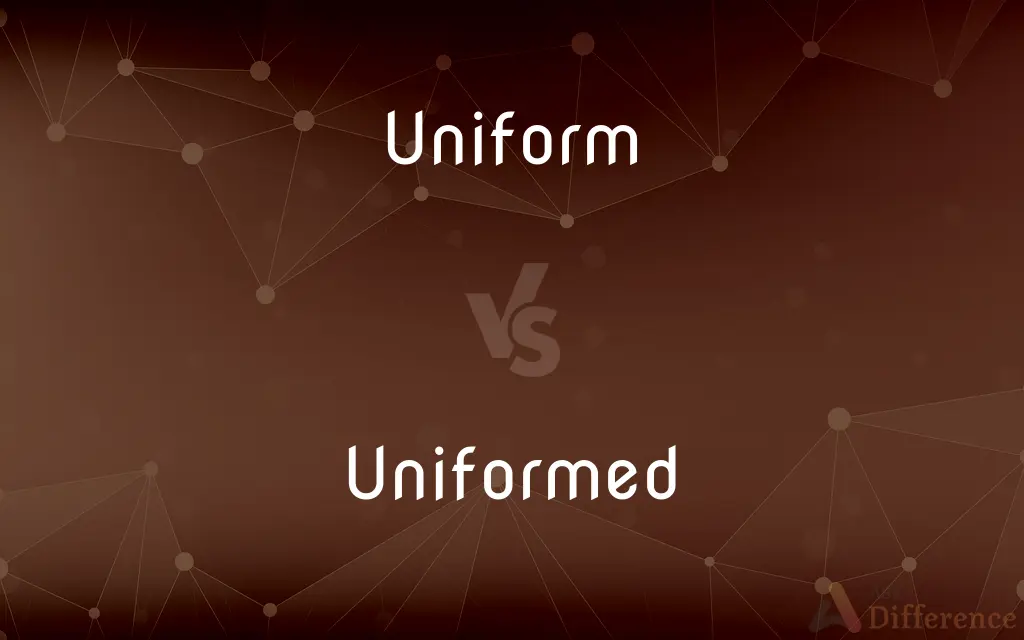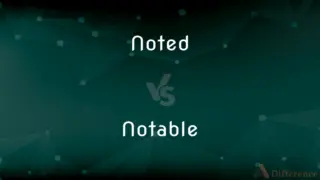Uniform vs. Uniformed — What's the Difference?
By Urooj Arif & Maham Liaqat — Updated on April 16, 2024
"Uniform" refers to a distinctive clothing set worn by members of an organization, whereas "uniformed" describes someone wearing such a uniform.

Difference Between Uniform and Uniformed
Table of Contents
ADVERTISEMENT
Key Differences
A uniform is a specific type of clothing designed to be a standard issue within an organization like the military, police, or school, ensuring that all members are dressed alike. On the other hand, "uniformed" is an adjective that describes individuals who are wearing uniforms, indicating their association with a particular group or role.
Uniforms are often required to convey identity, status, and professionalism within the group, promoting a sense of equality and unity among its members. In contrast, the term "uniformed" focuses on the state of wearing this attire, often used to highlight the presence or actions of those in service roles during discussions or reports.
While uniforms can come in various styles and colors specific to different roles or ranks within an organization, the term "uniformed" universally applies to anyone who dons these outfits, regardless of the distinctions in the uniform's design.
Institutions like schools or companies adopt uniforms to streamline dress codes and reduce social pressures related to attire. Conversely, describing someone as "uniformed" generally sets expectations for their behavior and responsibilities, underscoring their duty and authority in public or work settings.
Uniforms serve not only functional purposes like safety and visibility but also symbolize the traditions and values of the organization. Meanwhile, when individuals are referred to as "uniformed," it often emphasizes their readiness and capacity to perform specific tasks associated with their roles.
ADVERTISEMENT
Comparison Chart
Definition
Standardized clothing for an organization
Describing someone wearing a uniform
Purpose
Identity, equality, professionalism
Indicates association with a specific role
Context Usage
Institutional policy, group identity
Individual description, action contexts
Symbolism
Represents an organization’s values
Represents readiness and role fulfillment
Functional Role
Safety, visibility, tradition
Highlights active duty and authority
Compare with Definitions
Uniform
Standard attire for members of a specific group.
The school's uniform includes a blue blazer and khaki trousers.
Uniformed
Implies professionalism and authority.
Uniformed staff at the event ensured security.
Uniform
Often required for safety and identification.
Firefighters wear uniforms that are resistant to heat and flames.
Uniformed
Highlights the role and responsibilities.
Uniformed personnel are expected to uphold the law.
Uniform
Designed to promote equality among wearers.
Company uniforms help to minimize personal attire disparities at work.
Uniformed
Suggests readiness to perform duties.
The uniformed volunteers helped during the disaster recovery.
Uniform
Reflects institutional values and traditions.
Military uniforms vary historically and culturally, reflecting each service's traditions.
Uniformed
Describes someone wearing a uniform.
The uniformed officer directed traffic.
Uniform
Symbolizes authority and belonging.
Police uniforms are recognized universally and respect authority.
Uniformed
Often seen in service-related contexts.
Uniformed crew members aboard the plane assisted passengers.
Uniform
A uniform is a type of clothing worn by members of an organization while participating in that organization's activity. Modern uniforms are most often worn by armed forces and paramilitary organizations such as police, emergency services, security guards, in some workplaces and schools and by inmates in prisons.
Uniformed
Always the same, as in character or degree; unvarying
Planks of uniform length.
Uniform
Always the same, as in character or degree; unvarying
Planks of uniform length.
Uniformed
Being the same as or consonant with another or others
Rows of uniform brick houses.
Uniform
Being the same as or consonant with another or others
Rows of uniform brick houses.
Uniformed
A distinctive set of clothing intended to identify the members of a specific group
A police uniform.
Uniform
A distinctive set of clothing intended to identify the members of a specific group
A police uniform.
Uniformed
To make (something) uniform.
Uniform
To make (something) uniform.
Uniformed
To provide or dress with a uniform.
Uniform
To provide or dress with a uniform.
Uniformed
Dressed in a uniform.
A uniformed chauffeur collected us for the party.
Uniform
Unvarying; all the same.
Uniformed
In an occupation that requires a uniform, such as the police force or military.
Uniform
Consistent; conforming to one standard.
Uniformed
Simple past tense and past participle of uniform
Uniform
(mathematics) with speed of convergence not depending on choice of function argument; as in uniform continuity, uniform convergence
Uniformed
Dressed in a uniform;
Uniformed policemen lined the President's route
Uniform
Composed of a single macromolecular species.
Uniform
(geometry) (of a polyhedron) That is isogonal and whose faces are regular polygons; (of an n-dimensional (n>3) polytope) that is isogonal and whose bounding (n-1)-dimensional facets are uniform polytopes.
Uniform
A distinctive outfit that serves to identify members of a group.
Uniform
(international standards) nodot=1 NATO/ICAO Phonetic Alphabet.}}
Uniform
(police) A uniformed police officer (as opposed to a detective).
Uniform
(transitive) To clothe in a uniform.
Uniform
Having always the same form, manner, or degree; not varying or variable; unchanging; consistent; equable; homogenous; as, the dress of the Asiatics has been uniform from early ages; the temperature is uniform; a stratum of uniform clay.
Uniform
Of the same form with others; agreeing with each other; conforming to one rule or mode; consonant.
The only doubt is . . . how far churches are bound to be uniform in their ceremonies.
Uniform
A dress of a particular style or fashion worn by persons in the same service or order by means of which they have a distinctive appearance; as, the uniform of the artillery, of the police, of the Freemasons, etc.
There are many things which, a soldier will do in his plain clothes which he scorns to do in his uniform.
Uniform
To clothe with a uniform; as, to uniform a company of soldiers.
Uniform
To make conformable.
Uniform
Clothing of distinctive design worn by members of a particular group as a means of identification
Uniform
Provide with uniforms;
The guards were uniformed
Uniform
Always the same; showing a single form or character in all occurrences;
A street of uniform tall white buildings
Uniform
The same throughout in structure or composition;
Bituminous coal is often treated as a consistent and homogeneous product
Uniform
Not differentiated
Uniform
Evenly spaced;
At regular (or uniform) intervals
Common Curiosities
What does 'uniform' refer to?
'Uniform' refers to standardized clothing worn by members of an organization to denote identity and equality.
How does one describe a 'uniformed' person's role?
A 'uniformed' person’s role is typically associated with specific duties and responsibilities, often related to security, service, or enforcement.
Can 'uniform' refer to something other than clothing?
Yes, 'uniform' can also describe anything standardized or consistent in form and not varying.
What impact does wearing a uniform have in professional settings?
Wearing a uniform in professional settings promotes professionalism, facilitates immediate recognition, and enhances trust among the public.
What are the benefits of being 'uniformed' in a service role?
Being 'uniformed' in a service role conveys authority and professionalism, making it easier to fulfill responsibilities effectively.
What does 'uniformed' mean?
'Uniformed' describes individuals who are wearing uniforms, highlighting their roles and association with a specific organization.
Why are uniforms important in schools?
Uniforms in schools help to reduce social distinctions among students, fostering a focused educational environment.
How does the design of a uniform affect its functionality?
The design of a uniform affects its functionality by incorporating features suited to specific tasks, such as durability, comfort, and necessary protective elements.
Are there laws regulating the wearing of uniforms?
Yes, there are specific laws and regulations governing who can wear certain uniforms, particularly in the context of police, military, and other official roles.
How do uniforms contribute to team spirit?
Uniforms contribute to team spirit by creating a sense of unity and belonging among members, promoting a collective identity.
How do uniformed workers impact public perception?
Uniformed workers positively impact public perception by presenting an image of orderliness and readiness, which enhances public trust.
Can wearing a uniform affect an individual's behavior?
Yes, wearing a uniform can affect an individual’s behavior, often enhancing their sense of responsibility and aligning their actions with the values of the organization.
Is it mandatory to wear uniforms in all schools?
It is not mandatory in all schools, but many educational institutions implement a uniform policy to support a disciplined learning environment.
What are the cultural significances of uniforms?
Uniforms hold cultural significance as they embody the heritage, values, and ethos of the organizations they represent.
What should one consider when designing a uniform?
When designing a uniform, considerations should include the nature of the tasks, the environment in which it will be worn, and the necessary features for safety and comfort.
Share Your Discovery

Previous Comparison
Noted vs. Notable
Next Comparison
Utility vs. ProfitAuthor Spotlight
Written by
Urooj ArifUrooj is a skilled content writer at Ask Difference, known for her exceptional ability to simplify complex topics into engaging and informative content. With a passion for research and a flair for clear, concise writing, she consistently delivers articles that resonate with our diverse audience.
Co-written by
Maham Liaqat













































